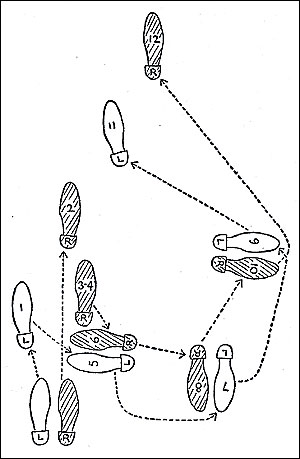Rhythm underlies every aspect of our existence, from the beating of our heart to the gait of our walk. Edith Sitwell (British poet, 1887-1964) said, "Rhythm might be described as, to the world of sound, what light is to the world of sight."
The circuit provides a hub in the lives of those who have access to its technology, in which the multitasking of life's routines shapes the rhythm of our lives. Through organizing gesture, sound, object, image, and word, rhythm gives discipline to our earliest attempts to communicate as a society. Today, every form of representation needs rhythm to be effective, whether the sweep of Frank Gehry's (American architect, born 1929) Disney Center in Los Angeles, or the repetitious scintillation of Philip Glass's (American composer, born 1937) music, or the unending syncopations of John F. Simon, Jr.'s (American digital artist, born 1963) digital grid. Bad design lacks good rhythm: "It don't mean a thing if it ain't got that swing."
Our ancestors had to understand the cycle of the seasons to hunt and to harvest. From the Sumerians to the Romans, the understanding of rhythm and order led to the construction of great edifices, the strategies of great armies and the use of language to understand ourselves. Until the Renaissance, the Western visual world sought harmony in spatial compositions through a juxtaposition of parts to create symmetrical arrangements.

Navajo Two Grey Hills rug, c. 1960
Equilibrium was maintained while holding forces together, whether in painting, music, or architecture. This can be seen in the simple forms of the Byzantine icons of any Romanesque church. These compositions achieved balance between fullness and emptiness, light and dark strokes, straight lines and curves. Everything could be broken down into measurable units or grids: patterns that were both graceful and stable.
- Charles Baudelaire,
Theophile Gautier
With the Renaissance and the rise of humanism, secular and erratic notions begin to intertwine with once-static symmetry. Mathematics, and aesthetic organization based on geometric forms, enabled more complex uses of proportion, balance, and harmony. Movement, on the other hand, was of less concern to the management of space until the advent of the Industrial Revolution in the West and the ensuing mechanization of the nineteenth century. Speed and travel created displacement, and the elements of balance and symmetry had to be rethought. It was Dynamism that echoed the rhythm of culture. It was seen in the blur of a photograph or the frenetic staging of an opera, and heard in new atonal music and the aerodynamic design of a car, even in the grind of the factory conveyor belt. The stable patterns of the past erupted into new rhythms brought forth from the communality of experience not just with the state and church, but also with everyday things. CÚzanne (French painter, 1839-1906) displaced an apple, Picasso (Spanish-born painter, 1881-1973) fragmented a horse, and Joyce (Irish-born writer, 1882-1941) recorded a stream of thought.

Foxtrot no. 7
learn how to
rhyme
You better
learn how to
add.
It's
mathematics
- Mos Def
The Constitution of the United States set forth ideals that are universal, and represent the very model of democracy—fairness, equality, independence, togetherness, order. This great document of will lives in our consciousness primarily because of its carefully wrought cadence. We recognize it not only by its shape and contours as writing on parchment, but also as a statement of principles. Because it was meant to be read aloud, it used an oral rhythm. Its Homeric line—"We hold these truths to be self-evident: that all men are created equal"—resounds because of its rhythm. The text uses rhetorical techniques that have their origin in the classical practice of oratory, and is all the more remarkable for the fact that Thomas Jefferson (American statesman and former President, 1743-1826) wrote it, Benjamin Franklin (American inventor and statesman, 1706-90) embellished it, and many conceived it in a heroic collaborative effort. It demonstrates the syncopation of many creative minds, an interactivity established through its rhythm, which enabled one writer to continue the pace of another.
The advent of the motion picture in the twentieth century is dynamic, successful because of its rhythmic structuring of music, sound, image, and illusion that are integrated with the narrative. The viewer suspends disbelief to be lost in the rhythm of gelatinous space, and is moved in effortless cadence anywhere in the imagination. When we are able to recognize the rhythm of our past patterns of experience, we learn from them while continuously repositioning ourselves in space. Looking down from a hot-air balloon in the eighteenth century created new perspective, and the speed of its flight anticipated momentous changes in the rhythm of daily life. From this point on, equilibrium was no longer static.
- Françoise Sagan
Our experience in the realm of the circuit is one of hyper-movement, as anyone reading this is experiencing right now. Everything is in flux as we navigate though the filament of electronic signals, experiencing virtual structures. But this can be most frustrating until we find a rhythm that gives form to the void and a pace to the form and, therefore, order to its never-ending choices. In cyberspace, the body seeks a tangible structure, and we are humanized by our creative management of algorithms into a rhythm of meaningful relationships.
Rhythm is the syntax and matrix that enables movement between ideas, programs, and computers. Sophisticated algorithms are capable of looking at, and making decisions about, a task. These algorithms are able to distinguish the differences between a lampshade and a hat. Although human beings are very good at this, teaching a machine to do so is not easy. We have made great strides in programming computers with this capability, not only in vision, but also in haptic function. These developments, which lead to "intelligent" robotics that are capable of fulfilling menial tasks as well as more sophisticated ones, may ultimately relieve us of many burdensome activities.
Now Chris's body, which was a part of that larger pattern, was gone. But the larger pattern remained. A huge hole had been torn out of the center of it, and that was what caused all the heartache. The pattern was looking for something to attach to and couldn't find anything. That's probably why grieving people feel such attachment to cemetery headstones and any material property or representation of the deceased. The pattern is trying to hang on to its own existence by finding some new material thing to center itself on.
- Robert Pirsig, Zen and the Art of Motorcycle Maintenance
